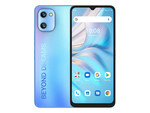Umidigi A13s
Ausstattung / Datenblatt

Secondary Camera: 8 MPix (f/2.2)
Preisvergleich
Testberichte für das Umidigi A13s
Quelle: OI Spice Tech News
 EN→DE Archive.org version
EN→DE Archive.org versionUmidigi A13s is the latest 4G smartphone that lies in the budget segment and was announced in March 2022. The A13s features a big 6.7 inches IPS LCD display panel with HD+ resolution. There is no news about the Gorilla glass protection while the software rendering is held through the Android 11 OS. Besides this, the device is powered by the 12nm Unisoc Tiger T310 chipset that can reach up to a max of 2GHz clocking speed. You can avail the phone in 4GB RAM with 32GB / 64GB internal storage option. Moreover, you can also extend storage with the SD card slot. The Umidigi A13s equips a dual-rear camera with a 16MP main and an 8MP ultrawide lens. For video calls and selfies, you will receive an 8MP front camera, while both the cameras can record 1080p videos at 30fps with no stabilization support. Apart from this, you are offered necessary comms and sensors such as GPS, Bluetooth, WiFi, Radio, etc. The battery section is the strength of this smartphone as it holds a massive Li-Po 5150 mAh battery capacity with support for 10W standard charging.
Einzeltest, online verfügbar, Kurz, Datum: 08.07.2022
Kommentar
Imagination PowerVR GE8300: Integrierter Grafikchip für ARM-Prozessoren der unteren Mittelklasse.
3D Spiele sind auf diesen Vertretern nur in Ausnahmen spielbar, grundsätzlich sind die Grafiklösungen hierfür jedoch nicht geeignet. Office Programme und Internet surfen dürfte jedoch ohne Problem möglich sein.
» Weitere Informationen gibt es in unserem Notebook-Grafikkartenvergleich und der Benchmarkliste.
T310: Einstiegsprozessor mit 4 Kernen in zwei Cluster. Ein großer ARM Cortex-A75-Kern mit bis zu 2 GHz und drei kleine Cortex-A55-Kerne mit bis zu 1,8 GHz.» Weitere Infos gibt es in unserem Prozessorvergleich Vergleich mobiler Prozessoren und der Prozessoren Benchmarkliste .

